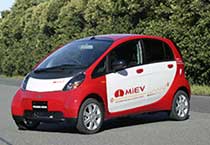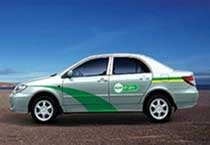Energy-Efficient Vehicles: All-Electric Vehicles
One solution for the problem of carbon dioxide (CO2) emissions is the electric vehicle, which does not produce any emissions. The internal combustion engine is replaced by an electric motor, powered by rechargeable batteries rather than gasoline or other burnable fuels. In the long term, the goal is to get the electricity from a clean energy source, giving electric vehicles an even smaller carbon footprint.
Electric vehicles have been in development a very long time. The big problem was and is the battery technology. Right now, current models can go only 80 to 160 km (50 to 100 mi) before requiring a recharge. But automakers see electric vehicles as the wave of the future, once battery issues are resolved.
History of Electric Vehicles
Electric vehicles were among the first cars built during the early years of the automobile industry. The first independent vehicle to run on electricity was built in the 1830s in Scotland. The power source for this vehicle was not rechargeable, a significant problem. A number of other electric vehicles hit the roads through the 1800s, but the first real electric automobile appeared in 1891, from the workshop of William Morrison of Des Moines, Iowa. By 1897 a fleet of electric taxis were operating in New York City. In 1900, 28% of all the cars in the United States ran on electricity. However, shortly after that peak the popularity of the electric car went into decline. Henry Ford introduced the mass-produced, combustion-engine Model T, making autos accessible to the masses. By 1920 the electric car was all but gone, replaced by cars that could go farther and faster with more power. The transition to the internal combustion engine was aided by the fact that gasoline was readily available.
|
Thomas Edison worked for many years on a battery that could be used to power an automobile. Although his battery was not successful, he did own an electric car.
|
The CitiCar, built from 1974 to 1977, ran on the electricity produced by eight lead-acid batteries. The body of the lightweight vehicle was made mostly of plastic. Thus, the CitiCar could not meet the more-stringent safety standards of the late 1970s.
|
The idea of an electric car for the masses resurfaced in the 1960s. But it didn’t catch on until the 1970s, when concerns about pollution and rising gasoline prices dovetailed. The first electric vehicle was Vanguard-Sebring’s CitiCar, which came out in 1974. This tiny vehicle could go over 48 km/h (30 mph) and travel approximately 64 km (40 mi) on each charge. About 2,000 of these were built. The CitiCar was not very safe, and by 1976 the manufacturer stopped building them.
Electric vehicles were tested for other uses as well. The U.S. Postal Service bought 350 electric Jeeps for mail delivery in 1975. These vehicles could travel up to 64 km (40 mi) and had a top speed of 80 km/h (50 mph). Each vehicle required 10 hours of recharging time. This seemed to be a good use for an electric vehicle: short distances to travel over a limited time span. However, the program was discontinued.
In 1976 the U.S. Congress passed a law to spur the development of electric and hybrid vehicles. The law was aimed, in part, at improving battery technology. However, automobile manufacturers did not show interest until 1988. That year General Motors (GM) began to provide money for research toward building an electric car for the consumer market. That car, called the EV1, was manufactured from 1996 to 1999. The EV1 was available to consumers in California by lease only. Initially it was produced with a lead-acid battery. In 1999 GM switched to a nickel-metal hydride (NiMH) battery, which recharged better.
|
General Motors’ EV1 was the first electric car built by an American automobile maker. It was leased only in California. When General Motors stopped making the vehicle, the returned EV1s were destroyed. |
Toyota produced an electric version of its popular RAV4, a small sport utility vehicle. The RAV4 EV was available in California from 1997 until 2003. Although most were leased and then returned, a few later models were sold to consumers. These remain on the road. |
A number of other electric vehicles soon joined the EV1. The Toyota RAV4 EV, a plug-in version of the popular small sport-utility vehicle, was tested in Japan in the mid-1990s and marketed in California. Corporations could lease the RAV4 EV between the years 1997 and 2000. From 2001 to 2003 Toyota made the car available for personal lease in the United States, with some going on sale starting in 2002. However, by 2003 the RAV4 EV was discontinued. The RAV4 EV reached speeds of up to 130 km/h (80 mph) and had a range of 130 to 190 km (80 to 120 mi). It used NiMH batteries.
Very few of these first-generation modern electric vehicles still exist—most of the EV1s were taken back by GM and crushed. However, some of the RAV4 EVs remain on the road. There are no new electric vehicles on the world auto market at this time. However, most major car manufacturers are planning to offer electric vehicles in the near future.
What’s the Holdup?
The battery remains the big problem for electric vehicles. Developing this technology to work at a level that will please consumers has proved to be a tremendous hurdle. The batteries must be able to do a number of things well. They need to hold enough charge to allow the vehicle to travel a useful distance. They need to be able to generate enough horsepower to make the engine drivable for real-world use. They need to recharge relatively quickly. And the cost of replacing the batteries must be reasonable.
The first modern electric vehicles used 12-volt lead-acid batteries, the type used right now by most automobiles. These posed significant problems. Generating enough power for one vehicle required groups of batteries. For example, the EV1 used 26 batteries, arranged in a long T shape underneath the body and rear of the car. A single automotive lead-acid battery averages about 23 kg (50 lb); a group of 26 of these batteries weighs over 500 kg (1,100 lb) or more. The charge capacity for lead-acid batteries is limited, so the first electric vehicles had a range of only about 80 km (50 mi) before needing a recharge. The batteries took four to ten hours to fully charge back up, taking the vehicle out of service for significant periods. The lead-acid batteries required replacement every three to four years, at a cost of about US$2,000 as of 2007. As happens with many other types of batteries, cold weather drains power from lead-acid batteries, so electric vehicles were much less effective in places with cold winters.
The switch to nickel-metal hydride (NiMH) batteries in the late 1990s was an improvement. These batteries hold much more power than lead-acid batteries and thus give the car a longer range and more power. However, groups of batteries are still needed, NiMH batteries are as heavy as lead-acid batteries, and their recharge time is comparable to that of lead-acid batteries. In addition, NiMH batteries have one big drawback: They are much more expensive to replace (US$12,000 to $16,000 as of 2007). This is due to the amount of battery needed to produce enough energy to power the vehicle.
The next generation of batteries is the lithium-ion (Li-ion) battery. These batteries are very energy dense, meaning that a significantly lighter weight can hold as much as energy as the NiMH batteries can. Li-ion batteries can thus go farther on a charge. In addition, they can recharge more quickly. All of the new electric vehicles under development are using Li-ion batteries.
Current Status of Electric Vehicles
In the late 1990s and early 2000s, it looked as though the electric car was really going to happen. But the limitations of battery technology proved too steep. Hybrids have become a very popular alternative, at least as a stopgap. The automotive industry remains committed to electric vehicles. Experts believe that the advances in Li-ion batteries will resolve many of these issues and that consumers will view electric vehicles in a new light.
There are lots of electric vehicles under development around the world. Major Japanese automakers have all announced that they will have electric cars on the market in the near future. Chinese battery maker BYD is also working on an electric vehicle. Some of the new electric vehicles will be larger, to suit consumers in the United States.
|
The Volt, an electric car from General Motors’ Chevrolet division, will be sold starting in 2010.
|
Mitsubishi is entering the electric car market with its i MiEV. |
Chinese automobile maker BYD is developing the all-electric F3e. |
This content has been re-published with permission from SEED. Copyright © 2025 Schlumberger Excellence in Education Development (SEED), Inc.


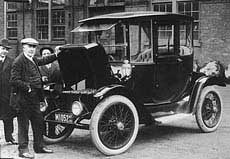
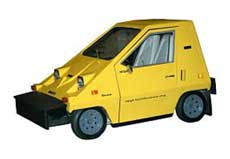
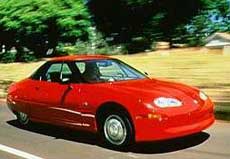
.jpg?n=4964)

